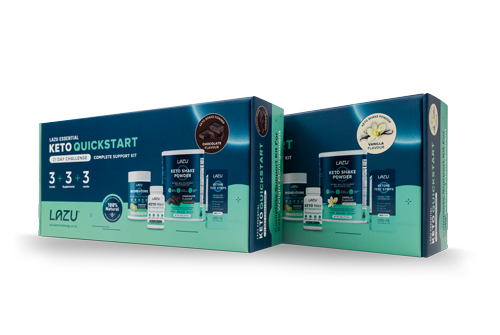
The keto diet is a low-carb, moderate-protein, and high-fat diet that has gained popularity over the years thanks to its effect on weight loss and possible health benefits.
Nowadays, there are several keto diets you can follow. There is the cyclical keto, modified keto, vegan or vegetarian keto. Two popular versions of the keto diet are dirty keto and clean keto.
The purpose of this article is to understand the difference between dirty keto and clean keto and determine which one is better.
What Is Dirty Keto?
Dirty keto follows the same principles as a keto diet. It is a low-carb and high-fat diet. However, in this case, most foods consumed are processed, meaning the foods are not highly nutritious.
So, as long as you hit your macros, it doesn’t matter where the food comes from.
There are some pros to following a dirty keto approach.
- Can be cheaper than clean keto.
- Less restrictive food choices.
- Requires less preparation.
However, while there are some benefits, there are also some cons.
- Can promote nutrient deficiency.
- Could lead to weight gain if calories are not controlled.
- Might increase the risk of chronic illnesses.
So, to get a better understanding of a dirty keto approach, here are some of the most common foods people typically eat.
- Bacon
- Processed cheese
- Pork rinds
- Deli meat
- Pre-packaged meals
- Cheese crisps
- Low-carb desserts
- Processed vegetable oils
- Low-carb fast food meals
- Diet soda
What Is Clean Keto?
Opposite to dirty keto, clean keto focuses on consuming nutrient-dense foods. In this approach, there is a high emphasis on the food’s quality, always choosing fresh over processed.
In clean keto, there is also a special consideration for the food’s sources. For example, when choosing a meat source, choose grass-fed, wild-caught fish or free-range eggs.
Also, when selecting fats, it’s recommended to choose healthy fats such as avocado, olive oil, nuts, and seeds over options such as butter, mayo, and sour cream.
Remember to include non-starchy vegetables. They supply essential nutrients such as fiber, vitamins, and minerals. Including at least 4-5 servings of vegetables can help reduce digestive issues such as constipation and decrease nutrient deficiency.
As for things to drink, you can drink water, tea, coffee, protein shakes, milk alternatives, vegetable juice, kombucha, and sparkling water.
There are several benefits to following a clean keto approach.
- Can promote weight loss thanks to a ketosis state.
- Emphasis on nutrient-dense and healthy foods.
- Might decrease the risk of heart disease.
- Promotes better digestion due to larger fiber intake.
Still, there are some drawbacks to following a clean keto approach.
- Can become monotonous if you eat the same foods every day.
- Might be expensive.
- Requires more discipline to stay on track.
Differences Between Dirty Keto And Clean Keto
Now, you might be wondering which is the best to follow. However, before we make a decision, it’s important to analyze the main differences that would be
Food Quality
One of the biggest differences between dirty keto and clean keto is the quality of the food. As seen, clean keto focuses on eating fresh and clean ingredients, while dirty keto focuses mostly focuses on reaching the intended macros, no matter their origin.
Since this is the key differentiating factor between dirty and clean keto, it creates more differences between them, such as costs and convenience.
Convenience
Dirty keto might be easier for some to follow since it takes less time to prepare food. Dirty keto uses mostly processed ingredients or fast food. This shortens the time in the kitchen significantly.
Since clean keto uses fresh ingredients, you need to prepare and cook them, which can increase the time you spend in the kitchen. To make things easier, meal prep can help you save a lot of time and money, but still, it takes more time than following a dirty keto approach.
Cost
Finally, following a keto diet might be expensive. But, if, on top of that, you purchase organic, grass-fed or wild-caught products, it can increase its price. Following a clean keto approach might slightly increase the bills in the grocery store.
On the other hand, since a dirty keto uses processed foods and oils, it can be cheaper. That is why some people might prefer following a dirty keto approach.
Which One Is Better?
So, if you need to pick one, which one should you choose?
The answer might not be that simple. If you have to choose one over the other, clean keto is going to be better since you get more nutrients which can decrease the risk of nutrient deficiency and constipation.
However, it might be more expensive and hard to follow long term.
In that case, we recommend following a combination of them. Try to follow a clean keto approach at least 80% of the time, but you can have certain meals with ingredients that are processed.
Not only will this allow you to have a better outcome when following a keto diet, but it can also make it easier to follow in social environments. A keto diet is very restrictive, but knowing you have options when eating out can make it a lot simpler.
Make sure to focus your meals on clean ingredients, but once in a while, you can add certain foods that are slightly processed. As long as they are not the center of the meals (eating bacon and mayo all day long), there is no harm in adding them in moderation and a couple of times a week.
The Bottom Line
A keto diet can be a good approach to weight loss and obtain other health benefits such as better glucose support and a reduction in cholesterol levels. No matter which option you choose (clean or dirty), as long as you stay below 50 g of carbs per day, you enter ketosis.
Still, if you need to choose, make sure you follow a clean approach 80% of the time, and only 20% where you include highly processed foods. This can help decrease the risk of nutrient deficiency and prevent any unwanted negative health effects.
